This Hainanese Chicken Rice recipe 海南鸡饭 was listed as one of the “world’s 50 best foods” by CNN.
SAVEUR, the global guide to cooking, entertaining, and food travel, described it as one of Southeast Asia’s most beloved culinary exports.”
Besides all the global recognition, serving Hainanese chicken rice is deceptively simple. The chicken is poached at sub-boiling temperature and served with chili sauce, ginger-garlic sauce, and flavored rice.
In this article, I will show you step-by-step instructions on how to prepare Hainanese chicken rice. Let’s get started!
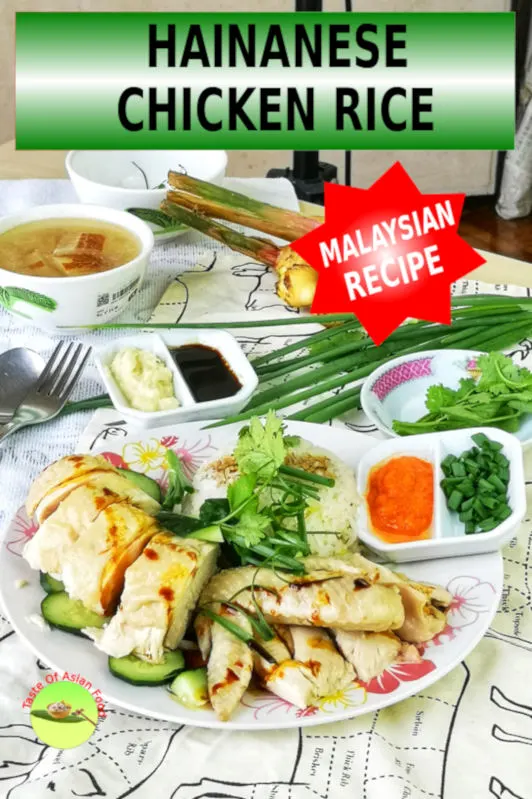
Note: This post may contain affiliate links. Please read my privacy policy for more info. I may receive commissions for purchases made through links in this post. As an Amazon Associate, I earn from qualifying purchases.
The Hainanese chicken rice recipe, a step-by-step guide
1. Poach the chicken
a. Prepare the chicken before poaching
- Boil a pot of water. You must get a large stock pot to put a whole chicken in. Fill up the pot with enough water to submerge the entire chicken. Bring the water to a boil.
- Prepare the aromatics. Meanwhile, cut some ginger into slices, mash a few cloves of garlic, and chop a large stalk of scallion (spring onion or green onion) into 5cm sections. Add these aromatic ingredients to the pot to flavor the water, or insert it into the chicken cavity and secure it with toothpicks. Ginger, garlic, and scallion are three ingredients frequently used in Chinese cooking as their flavors complement each other.
- Exfoliate the chicken with salt. Next, clean the whole chicken with running water. Remove the innards (my chicken vendor always does it for me). Then, use some coarse salt to rub the skin of the chicken. This step will remove any remaining hair from the skin, and the chicken will have a clean and smooth presentation after poaching.
b. Poach the chicken
- Shower the chicken with boiling water. After cleaning the chicken, hook it up or use tongs to hold it above the boiling water. Ladle the boiling water over the chicken for one to two minutes. The heat from the boiling water will contract the skin and adhere tightly to the meat so that it will not detach from the chicken during poaching.
- Simmer for twenty minutes. Now lower the chicken into the water. Increase to medium heat to bring the water to a boil quickly. The chicken must be submerged fully in the water to poach evenly. Add more water if necessary. Also, use a large pot so that the chicken will not touch the bottom of the pot,
- Once the water is boiling again, adjust to low heat until it is barely simmering at sub-boiling temperature, only with a few bubbles ascending to the surface. Poach the chicken for twenty minutes.
- If you have stainless steel poultry hooks, hang the chicken to the pot’s side. Chicken that stands vertically cooks more evenly. Put the chicken inside a large stockpot if you do not have the hook. However, the area touching the bottom may be overcooked due to the heat from the stove.
- After twenty minutes, switch off the stove and let the chicken continue cooking in the water for another twenty minutes (the exact cooking time depends on the size of the chickens and the amount of water.) Since there is plenty of chicken broth, it will cool down slowly, and the heat will continue penetrating deep down the skin. By the end of the second twenty minutes, every part of the chicken should have been thoroughly cooked. Since there is no high heat involved in the process, the meat is very tender and soft.
You can insert a kitchen thermometer into the thickest part of the meat to check the doneness. It should be at least 70°C/160°F, and no blood oozing when you remove the thermometer.
The water after poaching the chicken will be used to cook the rice. The leftover broth can be used to cook other dishes.
c. Soak the chicken in cold water after poaching
- Plunge the chicken into ice water to stop cooking instantly. Otherwise, the latent heat will keep cooking and toughen the chicken meat.
- Keep the chicken in the ice bath for twenty minutes or until completely cold.
- Remove the chicken from the ice bath and hang it to dry. The chicken is now ready.
- Cut the chicken into thick slices when the chicken returns to room temperature.
- Garnish with scallion and coriander leaves. Cut some fresh cucumber slices to serve together.
Note: Using chicken parts, such as chicken thighs or chicken breast, will not work properly to produce the best Hainanese chicken.
Important. The tender chicken skin can easily break and detach from the meat. Do not handle the chicken unnecessarily, and be gentle. Use a sharp knife to slice through the skin.
2. Cook the chicken rice
Rinse and drain the Jasmine rice, just like preparing the regular steamed rice.
There are two ways to proceed from here.
a. Method 1
Bashed a few cloves of garlic and an inch of ginger. Sauté them with chicken fat or cooking oil. Add the drained rice and stir-fry for a minute or until aromatic. The proponents of this method believe that rice is more fragrant after frying. The oil also lubricates every grain and makes it less sticky, preventing the rice from sticking together. Stir-frying rice is also the first step in making Zongzi.
b. Method 2
Sauté the garlic and ginger with the chicken fat or some vegetable oil until slightly brown. The excess fat is used for cooking the rice, giving it an aromatic flavor. Those who advocate this method think it is aromatic enough, and there is no need to fry the rice.
The subsequent steps are identical, regardless of which method you follow:
- Pour the rice, garlic, and ginger into the rice cooker.
- Add the salt, the chicken broth, and two to three pandan leaves.
- The chicken broth is about 1.5 the dry weight of the rice.
Most restaurants will add chicken bouillon to the rice to intensify the flavor. I will leave it to you whether you want to use chicken bouillon or you can purchase those with no MSG added.
Let the rice cooker do its work. Fluff the rice with a spatula once the rice is cooked. The rice will cake together if you leave it unattended.

3. Make the Hainanese chicken dipping sauce
The Hainanese chicken rice has three dipping sauces, which are all straightforward.
a. Ginger garlic sauce
The preparation of ginger sauce is simple. Blend the ginger, garlic, oil, salt, and chicken stock until homogenous. Use the mortar and pestle for a small amount.
b. Hainanese chicken rice chili sauce
- Blend the red chili, bird’s-eye chili (optional), garlic, ginger, salt, and sugar.
- Add a few drops of lime juice and dilute the sauce with chicken broth.
c. Soy sauce
- Mix all the ingredients: light and dark soy sauce, oyster sauce, sesame oil, and chicken broth in a small bowl. Some Malay stores use sweet soy sauce instead of light soy sauce.
- Drizzle on the Hainanese chicken with soy sauce before serving.
4. Prepare the Hainanese chicken soup
Hainanese chicken rice is not perfect if there isn’t a soup to serve with the chicken.
There is no standard soup, but most are simple soups that add vegetables to the broth after pitching the chicken.
One simple recipe is to make old cucumber and chicken soup.
- Boil the chicken feet we reserve earlier with the poaching liquid for twenty minutes. Remove the chicken feet.
- Cut an old cucumber into pieces and boil it with the broth until it becomes soft.
- Season with salt and pepper and serve.
Place the chicken on top of the bed of rice and serve it with chicken soup, ginger garlic, and chili sauce.
Origin controversy
Hainanese chicken rice is the Malaysian/Singapore adaptation of the Wenchang chicken from the Hainan province of China. There are a few stories about the origin of this rice.
One legend says that a Chinese called Wong Yi Guan came to Singapore in 1936. He started his chicken rice business by carrying the chicken rice in a bamboo basket with a pole hanging on his shoulder. After accumulating enough capital, he started Singapore’s first chicken rice restaurant. Since then, many restaurants have followed his successful Singapore Hainanese chicken rice recipe with their respective interpretations.
However, according to the Malaysian, the earliest Hainanese chicken rice was created by a migrant from the Hainan province called 梁居清. He set up the chicken rice store in Malacca in the ’20s and eventually moved to Klang in the ’30s.
Regardless of the controversy over who invented the authentic Hainanese chicken rice, it is the undisputed best-selling rice dish in Singapore and Malaysia. There are already three stores serving it within a five-minute walk from where I live. This Hainanese chicken rice recipe will closely follow the style of those famous chicken rice stores near me.
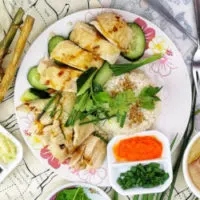
Hainanese Chicken Rice
Hainanese Chicken Rice was listed as one of the “world’s 50 best foods” by CNN in 2018.
Besides all the recognition received across the globe, serving Hainanese chicken rice is deceptively simple. The chicken is poached in sub-boiling temperature, serve with chili sauce and ginger-garlic sauce, and with flavored rice.
Ingredients
For the chicken
- 5cm length unpeeled ginger, sliced
- 3 cloves Garlic
- 1 stalk of scallion
- 1 whole chicken (about 1.8kg)
- 1 tbsp salt
- Water just enough to submerge the chicken
- Coarse salt for cleaning
For the rice
- 250g long grain rice
- 1 tbsp chicken fat or vegetable oil
- 3 cloves garlic, chopped
- 1 tbsp ginger, grated
- 1/2 tsp salt
- 2 Pandan leaves
- 350 ml chick broth
For the chili sauce
- 6 big red chili (100g)
- 3 bird’s eye chili (optional for extra hotness)
- 6 cloves (30g) garlic (
- 5 cm (25g) ginger
- 1/2 tsp salt
- 2 tsp sugar
- 2 tsp lime juice
- 80ml chicken broth
For the ginger-garlic sauce
- 90g ginger
- 30g garlic
- 20ml chicken broth
- 1/4 tsp salt
- 20ml cooking oil or chicken fat
For the soy sauce
- 2 tbsp light soy sauce
- 1 tbsp dark soy sauce
- 1/2 tbsp oyster sauce
- 1 tsp Sesame oil
- 2 tbsp chicken broth
For the soup
- 1 old cucumber, cut into pieces
- 400 ml chicken broth
- 1 tsp salt
- 1/8 tsp ground white pepper
- Chicken feet and neck for making the stock
Instructions
- Fill up the pot with enough water to submerge the entire chicken. Bring the water to a boil.
- Exfoliate the chicken with salt. Then clean the whole chicken with running water.
- Add the ginger, garlic, and scallion to the pot. Alternatively, put them inside the cavity of the chicken and secure with toothpicks.
- Ladle some boiling water to the chicken until the skin contracts and cooked. Hook up the chicken.
- Simmer the chicken for twenty minutes at sub boiling temperature.
- After twenty minutes, switch off the stove and let the chicken continue cooking for another twenty minutes.
- Soak it in cold water until it is cold.
- Cut the chicken into pieces.
- Garnish with scallion and coriander leaves. Cut some fresh cucumber to serve together.
- Rinse and drain the rice as for the regular steamed rice.
- Sauté the garlic and ginger with the chicken fat.
- Add the drained rice and stir-fry for a minute or until aromatic. Pour the rice, garlic, and ginger into the rice cooker.
- Add the salt, and the chicken broth from the pot, and a bunch of pandan leaves. Cook the rice with the rice cooker.
- When the rice is cooked, fluff the rice to avoid it from clumping together.
- Chili sauce. Blend all the ingredients until it forms a paste.
- Ginger garlic sauce. Blend all the ingredients until it forms a paste.
- Soy sauce. Mix all the ingredients until it is homogenous.
- Simmer the chicken broth with the chicken feet for 20 minutes. Remove the feet.
- Add the old cucumber pieces and boil until it becomes soft.
- Season with salt and pepper.
1. Poach the chicken
2. Cook the rice
3. Make the sauce
4. Prepare the chicken soup
Recommended Products
As an Amazon Associate and member of other affiliate programs, I earn from qualifying purchases.
-
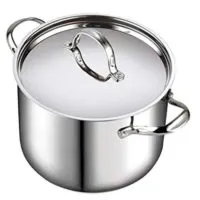 Cooks Standard 02520 Quart Classic Stainless Steel Stockpot with Lid, 12-QT, Silver
Cooks Standard 02520 Quart Classic Stainless Steel Stockpot with Lid, 12-QT, Silver -
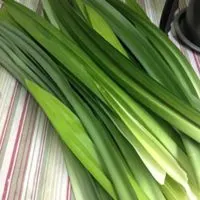 Fresh Pandan Leaves 4 oz. ( Rampe, La Dua, ใบเตยสด )
Fresh Pandan Leaves 4 oz. ( Rampe, La Dua, ใบเตยสด ) -
 ThermoPro TP03A Digital Instant Read Meat Thermometer Kitchen Cooking Food Candy Thermometer for Oil Deep Fry BBQ Grill Smoker Thermometer
ThermoPro TP03A Digital Instant Read Meat Thermometer Kitchen Cooking Food Candy Thermometer for Oil Deep Fry BBQ Grill Smoker Thermometer -
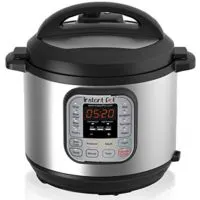 Instant Pot DUO60 6 Qt 7-in-1 Multi-Use Programmable Pressure Cooker, Slow Cooker, Rice Cooker, Steamer, Sauté, Yogurt Maker and Warmer
Instant Pot DUO60 6 Qt 7-in-1 Multi-Use Programmable Pressure Cooker, Slow Cooker, Rice Cooker, Steamer, Sauté, Yogurt Maker and Warmer
Nutrition Information:
Yield: 4 Serving Size: 1Amount Per Serving: Calories: 1343Total Fat: 77gSaturated Fat: 21gTrans Fat: 0gUnsaturated Fat: 43gCholesterol: 272mgSodium: 6878mgCarbohydrates: 69gFiber: 4gSugar: 14gProtein: 92g
This data was provided and calculated by Nutritionix on 8/22/2019

2025-11-20 : Soy Sauce Chicken Recipe – Authentic Chinese-Style (豉油鸡) Made Simple | 大脚印
Friday 21st of November 2025
[…] visit your favorite chicken rice store, you’ll often find a variety of choices, from the classic white-cut chicken to the flavorful braised soy sauce chicken (See yao gai/ […]
Soy Sauce Chicken Recipe – Authentic Chinese-Style (豉油鸡)
Sunday 16th of November 2025
[…] your favorite chicken rice store, you’ll often find a variety of choices, from the classic white-cut chicken to the flavorful braised soy sauce chicken (See yao gai/ […]
The Best One-Pot Hainanese Chicken Rice: Authentic Taste, Minimal Effort
Monday 17th of February 2025
[…] you want to try the traditional way of poaching an entire chicken, please read my Hainanese chicken rice blog post on the sister blog at Taste of Asian […]
Soy Sauce Chicken recipe (豉油鸡)- How to cook easy Chinese dish
Monday 27th of January 2025
[…] onions) are the triumvirate of aromatic ideal for the chicken. This combination is also used to poach the whole chicken and steam the entire chicken. It would be best to saute them until aromatic before adding them to […]
Lynn
Saturday 24th of April 2021
Hi, my chicken ended up bloody even though I followed the directions for poaching. Is it a good idea to pre soak the chicken in water to get rid of some blood?
KP Kwan
Sunday 25th of April 2021
Hi Lynn I would think the chicken is not fully cooked. The timing is only an estimation, as it depends on the amount of water in the pot and the size of the chicken. I suggest you increase the poaching time or keep it at a very slow boil for the first 5 minutes before turning off the stove to ensure it is cooked through. Best regards, KP Kwan